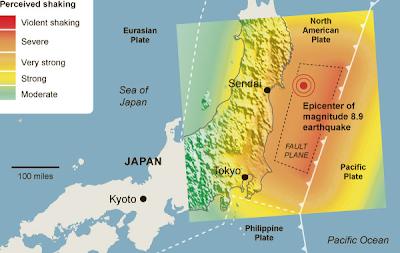The earthquake and tsunami of 2011 in Japan would always ring a bell as one of the extensive natural disasters that occurred in history. Also regarded as the Great Tōhoku Earthquake or the Great Sendai Earthquake, several catastrophic events brought by the force of nature struck northeastern Japan on March 11, 2011. It all began with a substantial earthquake that hit the northeast coast of the country’s main island, Honshu that resulted in rampant destruction on land and triggered massive tidal waves, which played havoc on Japan’s coastlines. Moreover, the tsunami also initiated a huge nuclear accident in the Fukushima prefecture.
The damage was widespread. No wonder as it was the most powerful earthquake ever occurred in Japan’s history, registering at 8.9 magnitudes. The quake was brought by the largest fault slip ever recorded. Experts estimated that the fault, the separation between two tectonic plates, in the Japan trench slipped nearly 164 feet.
Prior to the said tremor, the largest slip registered was the 98 to 131 feet fault skid in Chile in 1960, and the 9.1 Sumatra earthquake, which was produced by a 66 to 82 feet slide in fault. The fault movement in Japan, however, was relatively stronger, and the horizontal displacement of the plates thrust seawater up and caused the killer tidal waves.
While Japan has prepared decently and invested in buildings and coastlines that can withstand such massive earthquakes, the tremors’ power was overwhelming, causing extreme damages to seaports and airports. Not more than an hour after the quake hit, the first wave of the series of tsunamis struck the coastlines of the country. It reached heights of nearly 128 feet and surged inland as far as 10 kilometers or 6 miles, leaving many of the affected flooded with seawater.
The tsunamis surpassed and destroyed Japan’s protective seawalls at various locations, causing the doom of many three-story old buildings. High-rise towers, which were built to absorb sideway movements caused by tremors, remained standing but still received considerable damage. Nuclear power plants also halted operations across the country as a 15-meter tsunami struck Fukushima Daiichi reactors, disabling their power supply and cooling system. Three cores extensively melted in the first three days of the accident.
As of June 2026, the number of confirmed deaths was at 15,894, with around 2,500 people still recorded as missing.
Japan is not a newbie per se in these earthquakes. In 1923, the most catastrophic tremor hit Japan, when a 7.9 magnitude shake hit Yokohama and Tokyo, resulting in the death of nearly 143,000 people. Another massive earthquake hit the country in 1995, registering at 6.9 magnitudes. It killed over 5,000 people, leaving other 36,600 individuals injured.
So, why is Japan prone to such events? First is because of where the country sits on. Japan is situated along the renowned Pacific Ring of Fire, which is regarded as the most active tremor belt on the planet, where most of Earth’s volcanic eruptions and earthquake takes place. Second, Japan lies on the ‘junction’ of four different plates, the Eurasian Plate and North America Plate on the west, and the Philippine Plate and the Pacific Plate on the east. As these plates grind and mash with each other, they instigate such deadly earthquakes and ensuing tsunamis as what happened on March 11, 2011, in Japan.
More Readings
- Earthquake (Wikipedia)
- Tsunami (Wikipedia)
Related Posts

